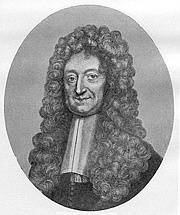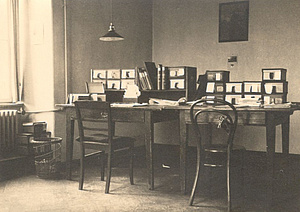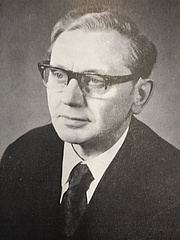Prehistory

In 1678, Charles du Fresne Dom Du Cange published his Glossarium Mediae et Infimae Latinitatis. Over the course of centuries, his oevre underwent repeated editing, the basic material though has not been changed.
When in 1919 the Union académique internationale (UAI)was founded, seven years before legal historians had already requested a new big project for developing a modern Medieval Latin.
After World War I, Germany remained excluded from the UAI until 1937. Until then, his interests were attended to by a Comité du Dictionnaire du latin médiéval.
Project Start and MLW Work until 1996

At the behest of Berlin Latinist Johannes Stroux († 1954), Dr. Otto Prinz († 2003) in 1939 began building a department in Munich with the Bavarian Academy of Sciences and Humanities. The department reported to a «Kommission für die Herausgabe eines mittellateinischen Wörterbuches», in 2015 replaced by the project committee for the «Projekt Mittellateinisches Wörterbuch». Shortly after beginning, Dr. Prinz was drafted for military service, he returned from Russian captivity only in 1948 (cf. Obituary by Prof. Dr. Peter Stotz in Akademie Aktuell 02/2003). The project was swiftly resumed, and after some preliminary works like e.g. the assembling of material, the first MLW fascicle was published in 1959.
For a good reason, the dictionary’s subtitle to this day names Paul Lehmann († 1964), since he contributed substantially to the founding of the project and its support since 1954.
As head of department, Otto Prinz was followed by Theresia Payr (until 1993 †), Peter Dinter (until 2000) and Heinz Antony (until 2008). Since 2008, management has been in the hands of Adelheid Wellhausen.

The time frame was defined by the period between 500 AD and 1280, the year Albertus Magnus died. Due to this specification, early Merovingian texts could be included in the MLW which were missing in the later founded, chronologically more narrowly defined Novum Glossarium mediae Latinitatis in the MLW, as well as Germanic legal texts and the terminology of scholasticism (before it split into numerous schools). In order to be able to adequately present also specialist literature, medical texts of the so-called Salerno Medical School as well as interesting material from the so-called Kingdom of Italy were included in the corpus. Therefor, the geographic boundaries extend well beyond the German speaking area, to the Frankish Empire in the west, to Poland in the east, to Great Britain in the north and to Sicily in the south (cf. The Dictionary).

The Berlin Department
In 1950, a second department was established in Berlin, managed by Dr. Johannes Schneider.
The difficulties in cooperating, mainly due to political reasons, were briefly overcome after the reunification (for more information see Akademie Aktuell 03/2003, S. 28).
Still, the Berlin Brandenburg Academy of Sciences and Humanities decided to close down the department at the end of 1996 (please find list of former associates here).
Current Situation
Today the MLW Munich department employs eleven scientific associates. Based on the material assembly, they develop the articles released in fascicles, published once or twice a year with C. H. Beck, Munich (copies with 80 two-columned pages). They are supported by national and international fellows and a part-time secretary.
A digital version of the MLW (see also MLW digital) was developed in cooperation with the Kompetenzzentrum für elektronische Erschließungs- und Publikationsverfahren in den Geisteswissenschaften an der Universität Trier.
In recent years, the cooperation with the BAdW IT department has been considerably intensified as well. Currently, the IT department is developing an XML interface, which will allow the associates upon completion of volume IV, to prepare the print template for the publisher and provide the data for the digital version at the same time.
Apart from that, work with the articles recently underwent some minor changes. Among others, the old German glosses were dropped and made accessible a.o. by an own project in the meantime. Since the Dictionary of Medieval Latin from British Sources (DMLBS) is already completely published, we by now mostly renounce citations of this language area. Also, comprehensive so-called “function words”, lemmata with little semantic substance (like e.g. demonstrative pronouns, the use of which can be described much better by grammar or stylistics), were for the time being completely eliminated from current article work starting with the letter I.
More information on this subject is supplied by the article by F.-J. Konstanciak in Akademie Aktuell 03/2003.
